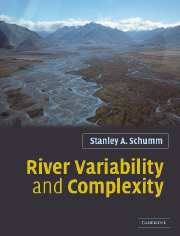Book contents
Chapter 2 - Types of rivers
Published online by Cambridge University Press: 05 June 2012
Summary
Before considering the variability of a single river, it is necessary to consider the different types of rivers that exist (Table 2.1). Once a topic is sufficiently comprehended, it appears logical to develop a classification of its components. A classification can provide a direction for future research, and there have been many attempts to classify rivers (e.g., Schumm, 1963; Mollard, 1973; Kellerhals et al., 1976; Brice, 1981; Mosley, 1987; Rosgen, 1994; Thorne, 1997; Vandenberghe, 2001). Indeed, Goodwin (1999) thinks that there is an atavistic compulsion to classify, and indeed, an individual's survival may depend on an ability to distinguish different river types (deep versus shallow).
Depending upon the perspective of the investigator, a classification of rivers will depend upon the variable of most significance. For example, the classic braided, meandering and straight tripart division of rivers (Leopold and Wolman, 1957) is based upon pattern with boundaries among the three patterns based upon discharge and gradient. Brice (1982, 1983) added an anabranched or anastomosing channel pattern (Figure 2.1) to the triad and distinguished between two types of meandering channels (Table 2.1). The passive equiwidth meandering channel is very stable as compared to the wide-bend point-bar meandering channel (Figure 2.2). This is a very important practical distinction between active and passive meandering channels (Thorne, 1997, p. 188). A highly sinuous equiwidth channel gives the impression of great activity whereas, in fact, it can be relatively stable (Figure 2.3).
Information
- Type
- Chapter
- Information
- River Variability and Complexity , pp. 9 - 17Publisher: Cambridge University PressPrint publication year: 2005
